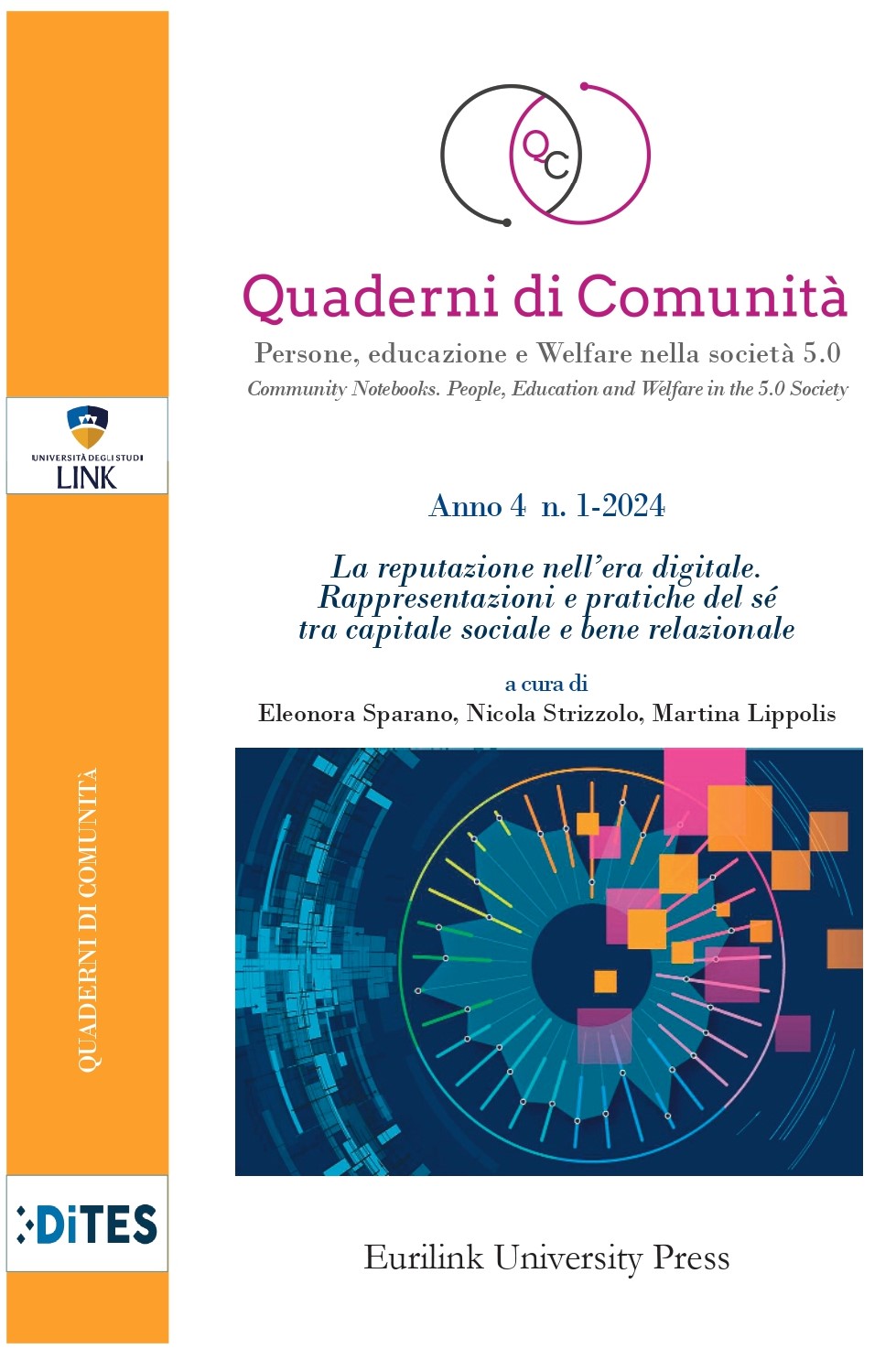Il posto degli anziani nella società 5.0: presenza legittima o cyberesclusione
DOI:
https://doi.org/10.61007/QdC.2024.1.257Parole chiave:
anziani, società 5.0, sviluppo tecnologico, cambiamenti, cyberesclusioneAbstract
Nelle società del XXI secolo i problemi che le persone anziane affrontano a causa del rapido sviluppo della tecnologia sono al centro di molte discussioni. La velocità dell innovazione introduce cambiamenti nella società e problematiche di adattamento oltre le capacità stesse degli anziani. Alcune domande alle quali cercano di rispondere gli autori del saggio sono: Ci stiamo volgendo verso un "panico" e un "determinismo" demografico o verso nuove opportunità creative di servizi tecnologici? Quanto siamo pronti digitalmente all invecchiamento della popolazione? Il nuovo modello di Società 5.0 sarà inclusiva e partecipativa verso gli anziani? Quali conseguenze sociali vivranno le fasce più anziani di una continua evoluzione tecnologica? Per rispondere, gli autori prenderanno in considerazione le implicazioni sociali dell invecchiamento della popolazione, i processi e i fenomeni che influenzano intere società e le istituzioni che si sviluppano a livello macrosociale.
Riferimenti bibliografici
Active Ageing: A Policy Framework, WHO (2002), Geneva, https://apps.who.int/iris/han-dle/10665/67215 [accessed on 18.01.2024].
Adamczyk M. (2019), Społeczne uwarunkowania pomyślnego starzenia się i aktywnego przygotowania do emerytury, Wydawnictwo KUL, Lublin.
Adamczyk, M., Betlej A. (2021), Social determinants of digital exclusion in an ageing society. The case of Poland,„Entrepreneurship and Sustainability Issues”, vol. 8, No. 3.
Adamczyk M., Karpiuk M., Soler U. (2023), The use of new technologies in education – opportunities, risks and challenges in the times of intensive intercultural change, “Edukacja Międzykulturowa”, No. 4 (23), pp. 175-185). ISSN 2299-4106 DOI: 10.15804/em.2023.04.12.
Adamczyk M., Lisiecka-Bednarczyk A., (2022), Obecność i bezpieczeństwo osób starszych w cyberprzestrzeni, „Cybersecurity and Law”, 8(2):219-229, DOI: https://doi.org/10.35467/cal/157184.
Badowska S. (2021) Cyfrowe usługi finansowe a seniorzy, Warszawa. Bakalarczyk R. (2021), Seniorzy – niewidzialni – obecni? Starzejące się społeczeństwo – prognozy, wyzwania, możliwości, Warszawa.
Batorski D. (2015), Polacy wobec technologii cyfrowych – uwarunkowania dostępności i sposobów korzystania [in:] Diagnoza społeczna 2015. Warunki i jakość życia Polaków, ed. J. Czapiński, T. Panek, Warszawa.
Bencsik A., Karpiuk M., Strizzolo N. (2024), Information society services and their cybersecurity, Cybersecurity and Law, 1, 258-270.
Bencsik A., Karpiuk M., Kelemen M., Włodyka E. (2023) Cybersecurity in the Visegrad Group Countries, Lex Localis Press, Maribor.
Beneito-Montagut, R., Rosales, A., & Fernández-Ardèvol, M. (2022). Emerging Digital Inequalities: A Comparative Study of Older Adults’ Smartphone Use. Social Media + Society, 8(4), 1-12. doi: 10.1177/20563051221138756.
Berkup S. (2014), Working With Generations X And Y In Generation Z Period: Management Of Different Generations In Business Life, “Mediterranean Journal of Social Sciences”, 5, 10.5901/mjss.2014.v5n19p218.
Bruggencate T., Katrien T., Katrien L., Janienke S. (2019) Friends or Frenemies? The Role of Social Technology in the Lives of Older People, “International Journal of Environmental Research and Public Health”. 16, 4969.10.3390/ijerph16244969.
Bruggencate T., Katrien T., Katrien L., Janienke S. (2017) Social needs of older people: a systematic literature review, “Ageing and Society”, 38, 1-26. 10.1017/S0144686X17000150.
Brunet A., (2020), Old and new models for the study of human ageing, “Nature Reviews Molecular Cell Biology”, 21, 10.1038/s41580-020-0266-4.
Capogna S (2022). Sociology between Big data and Research Frontiers. “Quality & Quantity”, p. 1-13. DOI: 10.1007/s11135-022-01351-7.
Carlo, S., & Sourbati, M. (2020), Age and technology in digital inclusion policy: A study of Italy and the UK. ESSACHESS – Journal for Communication Studies, 13(2), 107–127. DOI:10.21409/essachess.1775-352x)
CBOS (2018) Korzystanie z internetu, „Komunikat z Badań”, No. 62.
Chmielewski P. (2020), The dynamic nature of ageing: Novel findings, therapeutic avenues and medical interventions, “Anthropological Review”, 83, 75-92. 10.2478/anre-2020-0001.
Coluccia A. et al. (2020), Online Romance Scams: Relational Dynamics and Psychological Characteristics of the Victims and Scammers, “A Scoping Review Clin Pract Epidemiol Ment Health”, vol. 16.
Drabik, K. (2022), Cyberspace in a risk society, “Cybersecurity and Law”, 1, pp. 17-26.
Ejdys J., Soler U. (2023), The society’s attitude toward 5G technologies – a case study of Poland, “Technological and Economic Development of Economy”, Volume 29 Issue 5, pp. 1539–1558, https://doi.org/10.3846/tede.2023.20157.
Eurostat (2015), People in the EU: who are we and how do we live?, https://ec.europa.eu/eurostat/documents/3217494/7089681/KS-04-15-567-EN-N.pdf/8b2459fe-0e4e-4bb7-bca7-7522999c3bfd (accessed on 31.01.2024).
Eurostat (2023):
a) EU’s population projected to drop by 6% by 2100 (accessed on 31.01.2024)
b) Mortality and life expectancy statistics(accessed on 31.01.2024).
Eurostat (2024), Population structure indicators at national level (accessed on 31.01.2024).
Gawron G., Klimczuk A., Szweda-Lewandowska Z. (2021), Starzenie się populacji. Aktywizacja, koprodukcja i integracja społeczna osób starszych, Katowice.
Gergelewicz, T. (2022), Obszary budowania odporności na dezinformację jako element bezpieczeństwa infosfery, „Cybersecurity and Law”, 1, pp. 72-84.
Givskov, C., & Deuze, M. (2018). Researching new media and social diversity in later life. New Media & Society, 20(1), 399–412. doi: 10.1177/1461444816663949.
GUS (2020), Jakość życia osób starszych w Polsce, Warszawa.
GUS (2021), Sytuacja osób starszych w Polsce w 2019 roku, Warszawa 2021.
Holgersson J., Kävrestad J., Nohlberg M. (2021) Cybersecurity and Digital Exclusion of Seniors: What Do They Fear? [in:] Human Aspects of Information Security and Assurance. HAISA 2021, ed. S. Furnell, N. Clarke, Cham.
InfoSenior (2020), Raport Związku Banków Polskich, styczeń 2020, https://www.zbp.pl/getme-dia/76a9cdd8-a2da-4195-b5e1-b9d5f2c5adc0/ZBP_InfoSenior_2020_POPR4 (accessed on 16.01.2024).
Kaczmarek K. (2022), Digital Competencies of the General Public and the State’s Vulnerability to Cyberspace Threats, [in:] Karpiuk M., Kostrubiec J. (ed.), The Public Dimension of Cybersecurity, LEX Localis Press, Maribor, pp. 29-37.
Kilian M. (2020), Funkcjonowanie osób w starszym wieku, Difin, Warszawa.
Kochalska H. (2018), Kondycja portfela polskiego seniora, BIG InfoMonitor S.A., 1 października 2018, https://media.big.pl/informacje-prasowe/423493/kondycja-portfela-polskiego-seniora (accessed on 20.01.2024).
Majeed, Majeed & Adisaputera, Abdurahman & Ridwan, Muhammad. (2020), Digital Identity. Konfrontasi: Jurnal Kultural, Ekonomi dan Perubahan Sosial. 7. 246-252.10.33258/ konfrontasi2.v7i4.122.
McCrindle M., Wolfinger E. (2010), Generations defined. “Ethos” 18, 8-13.
Mihailidis, A., Simeonov, D., Horst, B.R., & Sixsmith, A. (2022). Older People’s Use of Digital Technology During the COVID-19 Pandemic. Bulletin of Science, Technology and Society, 42(1-2), 19-24. doi: 10.1177/02704676221094731.
Motylińska P. (2019), Wykluczenie cyfrowe [in:] Vademecum bezpieczeństwa informacyjnego, vol. 2, ed. O. Wasiuta, R. Klepka, Kraków.
Opieka geriatryczna w Polsce (2016) ed. A.M. Fal, I. Witczak, E. Kuriata-Kościelniak, Warszawa 2016.
Pieczywok A. (2023), Cyberspace as a source of dehumanization of the human being, “Cybersecurity and Law”, 1, pp. 40-47.
Pieczywok A., Wasilewska P, Wasilewski S. (2022), Threats to people with disabilities in virtual and environmental spaces – a comparison of behaviors, “Cybersecurity and Law”, 1, pp. 309-319.
Pieczywok A. (2019), The use of selected social concepts and educational programmes in counteracting cyberspace threats, Cybersecurity and Law”, 2, pp. 61-74.
Prensky M., (2001), Digital Natives, Digital Immigrants Part 1, “On the Horizon” 2001, vol. 9, No. 5.
Raport o samotności. Pierwszy rok pandemii (2021), Fundacja Szlachetna Paczka, https://www.szlachetnapaczka.pl/wp-content/uploads/2021/03/raport_o_samotnosci_2021.pdf (accessed on 22.12.2023).
Rasi, P., Vuojärvi, H., & Rivinen, S. (2021). Promoting Media Literacy Among Older People: A Systematic Review. Adult Education Quarterly, 71(1), 37–54. doi: 10.1177/0741713620923755.
Rescher N. (1987) Life’s Seasons: The Conceptual Phenomenology of Age-Periodization, [in:] Forbidden Knowledge. Episteme, vol. 13, Springer, Dordrecht. https://doi.org/10.1007/978-94-009-3771-0_9.
Rosales, A., & Fernàndez-Ardévol, M. (2020). Ageism in the era of digital platforms. Convergence: The International Journal of Research into New Media Technologies, 26(5-6), 1074–1087. doi: 10.1177/1354856520930905.
Sala, E., Gaia, A., & Cerati, G. (2020). The grey digital divide in social networking site use in Europe: Results from a quantitative study. Social Science Computer Review, 40(2), 328–345. doi:10.1177/0894439320909507.
Senior – konsument, https://uokik.gov.pl/aktualnosci.php?news_id=17994 (accessed on 20.12.2023).
Senior w świecie finansów. Poradnik klienta usług finansowych (2015), Warszawa.
Seniorze – spotkajmy się w sieci!, https://www.zbp.pl/aktualnosci/wydarzenia/Seniorze-%E-2%80%93-spotkajmy-sie-w-sieci! (accessed on 20.12.2023).
Seniorzy najbardziej narażeni na kradzież tożsamości, https://www.egospo-darka.pl/161452,BIK-seniorzy-najbardziej-narazeni-na-kradziez-tozsamosci,1,12,1.html (accessed on 17.01. 2024).
Shillair R. et al. (2015), Getting Grandma Online: Are Tablets the Answer for Increasing Digital Inclusion for Older Adults in the U.S.? “Educational Gerontology”, vol. 41, No. 10.
Skrzypniak N. (2018), Przystosowanie osób starszych do życia a kwestia bezpieczeństwa człowieka, „Dyskursy o Kulturze”, No. 9.
Taipale S., Wilska T.A., Gilleard C., (ed.) (2019). Digital Technologies and Generational Identity. ICT Usage Across the Life Course. London: Routledge.
Tomański R. (2019), Japoński człowiek nowej ery, czyli społeczeństwo 5.0, https://sektor3-0.pl/blog/japonski-czlowiek-nowej-ery-czyli-spoleczenstwo-5-0/(accessed on 17.01.2024).
Tanja, Schroeder & Dodds, Laura & Georgiou, Andrew & Gewald, Heiko & Siette, Joyce. (2023), Older Adults and New Technology: Mapping Review of the Factors Associated With Older Adults’ Intention to Adopt Digital Technologies. JMIR aging. 6.e44564.10.2196/44564.
Tirocchi, Simona & Crescenti, Martina & Cerase, Andrea & Taddeo, Gabriella. (2023), Tra spazi fisici e digitali. Come i giovani raccontano la pandemia attraverso il visual storytelling. 21. 239- 263.
Tyler, M., De George-Walker, L., & Simic V. (2020) Motivation matters: Older adults and information communication technologies. Studies in the Education of Adults, 52(2), 175-194. doi:10.1080/02660830.2020.1731058.
United Nations (2006), World Population Prospects The 2004 Revision, New York, (accessed on 31.01.2024).
Downloads
Pubblicato
Come citare
Fascicolo
Sezione
Licenza
Copyright (c) 2024 Quaderni di comunità

Questo lavoro è fornito con la licenza Creative Commons Attribuzione - Non commerciale - Non opere derivate 4.0 Internazionale.







